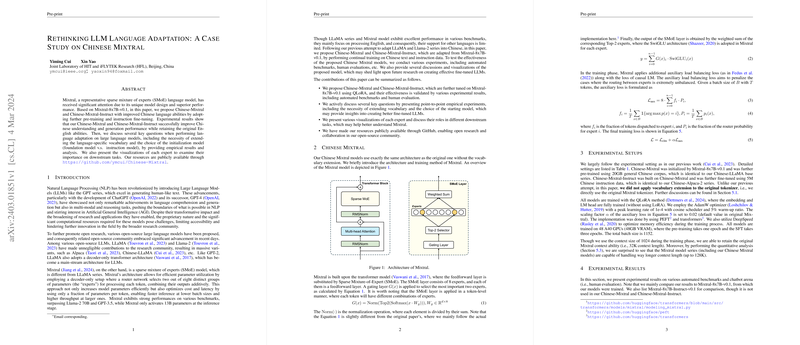Enhancing Chinese Language Performance in Mixtral Models Without Vocabulary Extension
Introduction to Chinese Mixtral
The advent of Mixtral, a sparse mixture of experts (SMoE) LLM, marks a significant step forward in the field of NLP. This paper extends Mixtral's capabilities into the Chinese language domain, introducing Chinese-Mixtral and Chinese-Mixtral-Instruct models. These versions uphold Mixtral's original architectural integrity while enhancing its performance on Chinese language tasks, including understanding and generation, without extending the model's vocabulary. The models retain their English language proficiency, offering a bilingual solution. Crucially, the paper examines key considerations in language adaptation for LLMs, such as the impact of language-specific vocabulary and the choice of initiation model (foundation vs. instruction model).
The Architecture and Training of Chinese Mixtral
Chinese Mixtral retains the original architectural specifications of Mixtral, employing the same transformer model foundation but specializing in handling Chinese language tasks. The model utilizes a Sparse Mixture-of-Expert (SMoE) layer, incorporating eight distinct "experts" or groups of parameters selectively activated during processing. This structure enables efficient parameter use and optimizes computational resource allocation. Training incorporates an auxiliary load balancing loss to ensure even routing among experts, addressing potential skewness in parameter utilization. The training utilized QLoRA methodology for embedding and LM head training, fostering an efficient learning environment for the Chinese adaptation.
Experimental Insights and Results
The effectiveness of Chinese-Mixtral and its instruction-tuned counterpart was verified through a comprehensive suite of benchmarks and evaluations. Despite not expanding the original Mixtral's vocabulary, the models demonstrated superior performance on various Chinese datasets, including C-Eval and CMMLU, illustrating their robust understanding and generative capabilities in both English and Chinese contexts. Notably, instruction fine-tuning on Chinese-Mixtral-Instruct significantly enhanced performance across tasks, underscoring the value of specialized fine-tuning in cross-lingual LLM adaptation.
Key Findings and Considerations
This investigation sheds light on several critical aspects of adapting LLMs to new languages:
- Vocabulary Extension: Contrary to common practice, extending the model's vocabulary with language-specific tokens was found not to be essential for achieving high performance in language-specific tasks. This finding suggests that the encoding efficiency provided by vocabulary extension may not translate into better model performance on downstream tasks.
- Choice of Initialization Model: The paper suggests a preference for using the foundation model as the starting point for language adaptation over an instruction-tuned model. This approach appears to better preserve the model's comprehensive language abilities and facilitates effective language transfer.
- Long-Context Abilities: Interestingly, Mixtral models, including the Chinese adaptations, demonstrated an inherent ability to handle context lengths beyond their specified design, indicating a versatile long-context capacity that may negate the need for additional fine-tuning for long-context handling.
Visualization and Expert Analysis
The paper presents an innovative visualization analysis, highlighting the distinct roles and importance of each expert within the model, especially in processing Chinese language tasks. This analysis offers intriguing insights into the inner workings of the SMoE architecture, revealing the intricate balance and specialization among experts that contribute to the model's overall performance.
Conclusion and Future Directions
The development of Chinese-Mixtral and Chinese-Mixtral-Instruct represents a significant advancement in the adaptation of LLMs for Chinese language processing. These models maintain efficiency and performance without necessitating vocabulary extension, challenging prevailing assumptions in the field. The insights gleaned on initialization models and the inherent long-context abilities of Mixtral open new avenues for research and application in multilingual NLP. By making these resources publicly available, this work encourages further exploration and collaboration within the open-source community, promising continued innovation in LLM adaptation and beyond.
